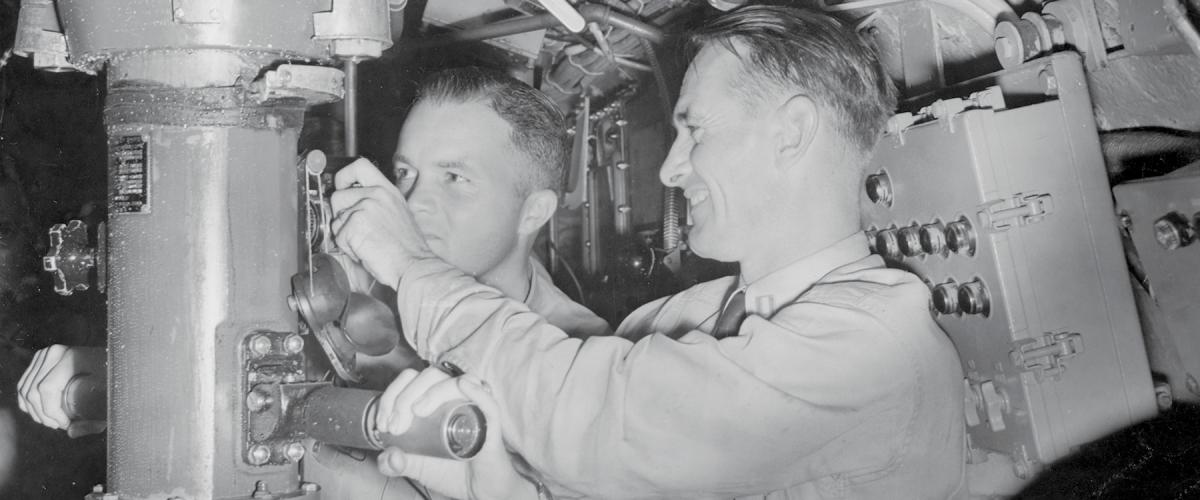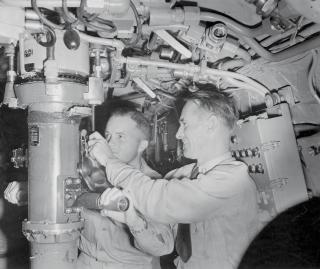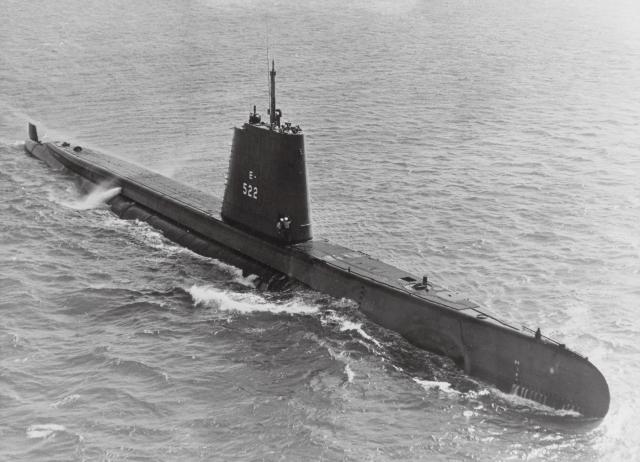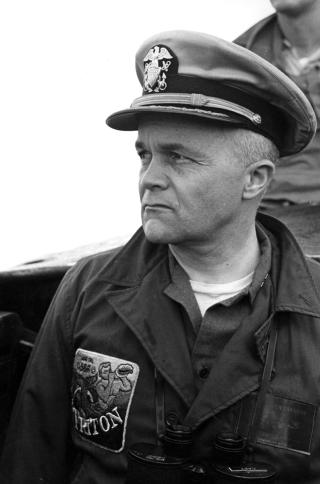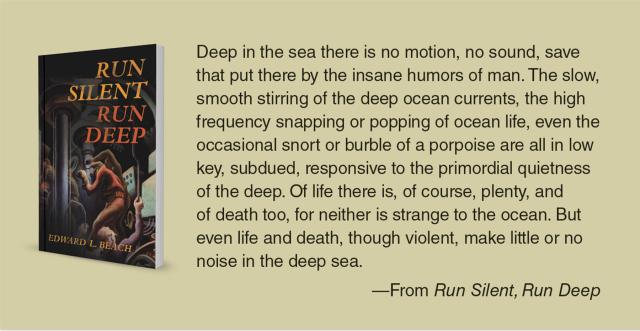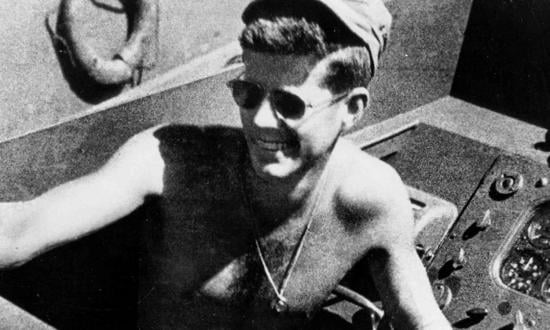0240: Battle stations. Approached anchorage from the South along the 10-fathom curve within 1200 yards of the shoreline. Took single ping fathometer sounding every 3 to 5 minutes. The smell of cattle from the beach was strong. . . .
This is not an exciting scene from Ned Beach’s classic 1955 novel, Run Silent, Run Deep; it is from an actual patrol report of the submarine USS Tirante (SS-420), 14 April 1945. Lieutenant Commander Beach was executive officer of the submarine as she penetrated a heavily mined and shoal-obstructed harbor in the East China Sea and, running dangerously close to the shore, sank an ammunition ship and two Mikura-class frigates before making a daring escape. For this courageous exploit, the Tirante was awarded the Presidential Unit Citation. George Street, the sub’s captain, earned the Medal of Honor and his exec the Navy Cross for their “gallantry and intrepidity.”
This alone would have been a pinnacle achievement for any naval officer, but it was only one of many accomplishments in the stunning career of Edward Latimer Beach Jr. Completing 12 war patrols, he was credited with sinking or damaging 45 enemy vessels. Besides his Navy Cross, his wartime decorations include two Silver Stars and two Bronze Stars. Beach’s citations include such phrases as “excellent judgment and keen understanding of attack problems,” “contributed directly to his vessel’s success in destroying or inflicting heavy damage upon enemy shipping,” “despite heavy close-range enemy gunfire,” and “undaunted by the enemy’s vicious anti-submarine measures.”
In December 1945, Commander Beach left sea duty to serve as personal aide to Admiral Louis Denfield, the Chief of Naval Personnel, during which time he played a key role in solving the bureaucratic nightmare of discharging more than a million sailors and establishing new personnel policies for the peacetime Navy, before moving to the Navy’s Atomic Defense Section in the Pentagon. He had a follow-on tour as captain of the USS Amberjack (SSN-522)—an experimental submarine that, under his command, pioneered many new tactics and procedures. Beach’s tour as the Amberjack’s skipper was cut short when, in August 1949, General Omar Bradley, the first Chairman of the newly formed Joint Chiefs of Staff, wrote to then–Chief of Naval Operations Denfield asking for “a young, capable officer in whom you have great confidence” to serve as his naval aide.
In 1953, after commanding the USS Trigger (SS-564), Beach again served as naval aide, this time to President Dwight D. Eisenhower, who had specifically asked for him, despite Beach’s rank as a junior commander, replacing the previous aide who was a rear admiral.
Certain that his days of commanding submarines were over, now-Captain Beach was happily surprised when he was named captain of the USS Triton (SSRN-586), a uniquely designed behemoth with two nuclear reactors—the only U.S. submarine so equipped. In 1960, she and her commander made history by sailing around the world—submerged for the entire voyage. The Triton followed the track of the first circumnavigation of the globe (1519–22), which was instigated and organized by Portuguese explorer Ferdinand Magellan, who died en route. For this exceptional venture, Beach was awarded the Legion of Merit and credited with taking “his ship into strange waters under difficult and frequently unknown conditions” while “proving man’s ability under trying conditions to accomplish prolonged submerged missions as well as testing new and complex equipment in the world’s largest submarine.”
All these sterling achievements—and many others, including several other important seagoing commands—were further burnished by an outstanding “spare-time” career as an author. He left an enviable and unique legacy as a writer. He penned six nonfiction books, including Around the World Submerged: The Voyage of the Triton (Holt, Rinehart and Winston, 1962); The United States Navy: 200 Years (Henry Holt and Co., 1986); and Salt and Steel: Reflections of a Submariner (Naval Institute Press, 1999). He coauthored several editions of the Naval Terms Dictionary (Naval Institute Press) and a photo essay, Keepers of the Sea (Naval Institute Press, 1983). His first published article appeared in Shipmate magazine in June 1946 and his last in Sea Power in July 2000—a total of 34, with many Proceedings and Naval History articles in between.
Most successful writers are either fiction or nonfiction authors; Ned Beach succeeded in both genres. His most famous work was the novel Run Silent, Run Deep. Highly acclaimed, it made the New York Times bestseller list and was later adapted as a movie starring Hollywood icons Burt Lancaster and Clark Gable. Two other novels followed: Dust on the Sea and Cold Is the Sea.
Ned Beach retired from the Navy in 1966 after 27 years of active service. He continued his naval ties, serving as the first Stephen B. Luce Chair of Naval Science at the Naval War College, where he also served as editor of the Naval War College Review.
If all that were not enough, he and his father—a naval officer and prolific author in his own right—played significant roles in the U.S. Naval Institute during much of its storied 150-year history. On his death in 2002, Edward L. Beach Jr. was laid to rest in the U.S. Naval Academy Cemetery, by dispensation just steps from the Institute’s headquarters. Flanking its main entrance is a plaque identifying the building as Beach Hall and with the words: “Named in Honor of a Father and Son Whose Achievements as Both Naval Officers and Authors Superbly Fulfilled the Objectives of the United States Naval Institute.”
There are likenesses of the two men on the plaque, and, appropriately, their bronze eyes gaze out on the flowing waters of the Severn River that ultimately find their way to the open sea.
Deep in the sea there is no motion, no sound, save that put there by the insane humors of man. The slow, smooth stirring of the deep ocean currents, the high frequency snapping or popping of ocean life, even the occasional snort or burble of a porpoise are all in low key, subdued, responsive to the primordial quietness of the deep. Of life there is, of course, plenty, and of death too, for neither is strange to the ocean. But even life and death, though violent, make little or no noise in the deep sea.
—From Run Silent, Run Deep



